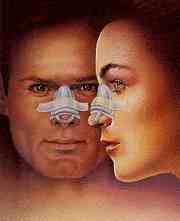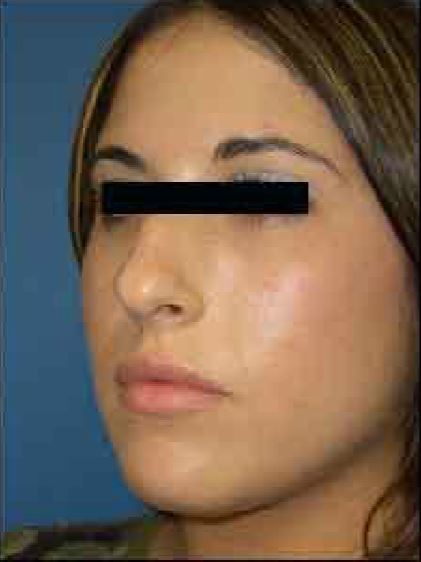Rhinoplasty or nose surgery
The nose is the appendix that differentiates humans from the rest of the animals. It is the most visible part of the face and for that reason it often constitutes a point of permanent suffering for those who see in themselves a lack of harmony, either due to their size, shape or position. Rhinoplasty or surgery to reshape the nose is one of the most common procedures of plastic surgery. Rhinoplasty can reduce or increase the size of your nose, change the shape of the tip of the nose or bridge of the nose, sharpen the opening of the nostrils or change the angle between the nose and the upper lip. You can also correct a birth defect or after a trauma, or help improve breathing problems.
The best candidates
People who want to improve their appearance, physically healthy, psychologically stable and realistic in their expectations, will be good candidates for this surgery. Age will be a topic to consider, since around the age of 15 the growth of the facial bones is completed, and the patient is able to undergo this surgery. The social and emotional aspects of adolescents are important, and it must be them and not their parents who want surgery. Small modifications in the shape of the nose can help rejuvenate the appearance of the face.
Planning your surgery
During the initial consultation, you will be asked what you want your nose to look like, we will evaluate the structure of both your nose and your face and explain the treatment possibilities to achieve your goal. We will also explain the factors that may influence the procedure and the results. These factors include the structure of the cartilage and bones of your nose, the shape of your face, the thickness of your skin, your age and your expectations. Be sure to let us know if you have previously had nasal surgery or a trauma to your nose, even if it was many years ago. It will also be of great contribution to know if you suffer from any type of allergy or difficulty in breathing; if you are taking medications, vitamins or drugs; or if you smoke.
Getting ready for your surgery
We will give you specific instructions on how to prepare for surgery, including certain suggestions about what you should eat and drink, about smoking, about what vitamins or medications you should take or avoid, and how to wash your face. Follow these instructions carefully, which will help your surgery to go unhindered and you will also have a more comfortable postoperative period. When making preparations, be sure to arrange for someone to accompany you home after surgery and help you for a few days, if necessary.
Where will your surgery be done?
The surgery is performed in the clinic, which has all the necessary medical equipment and the greatest comfort for you. You should arrive about 30 minutes before the scheduled time, to make the entry procedures, make a complete medical history, and take preoperative photographs. In your room, we will give you a sedative by mouth and you can change clothes. After the surgery, he will stay in the clinic for two to four hours, until we make sure everything is in order and he can return to his home, where he will continue to rest.
Types of anesthesia
Rhinoplasty can be performed under local or general anesthesia. We prefer local anesthesia, accompanied by mild sedation, since it has many advantages with respect to general anesthesia, such as less bleeding, good cooperation on your part, rapid recovery and much less risk than general anesthesia. With this local anesthetic, you will be lightly sedated, numbing your nose and surrounding area, which will make you feel no pain; You will be awake during surgery, however you will be relaxed and insensitive to pain.
Surgery



Rhinoplasty usually takes one to two hours, although more complicated procedures may last longer. During surgery, the skin of the nose separates from its bone and cartilaginous structure on which it rests, which is then sculpted into the desired shape. The type of remodeling will depend on your particular problem. Finally, the skin is placed on the new nasal structure. The rhinoplasty can be done through an access inside the nostrils, places where the insitions will be made and will be totally imperceptible, or in other more complicated cases can be done through the so-called “open way”, in which a small incision in the columella (skin between both nostrils). One or another technique will be carried out according to the case because each technique has its preferential indications. At the end of the surgery, a plaster or plastic splint will be applied over the nasal dorsum to help the nose maintain its new shape, which will remain in position for seven days. In some cases, nasal plugs should be placed in the nostrils, which are removed after 24 or 48 hours.
After surgery
After the surgery particularly during the first 24 hours, you will feel your face a little swollen. We can prescribe a medication for pain and control any discomfort. Plan to stay in bed with your head elevated (except to go to the bathroom) for the first day. It is likely that the swelling and bruising around the eyes increases at the beginning, reaching its maximum after two or three days. You can reduce this inflammation by applying cold compresses which makes you feel better. In any case, you will feel much better than you appear. Most inflammation or bruising (if you have it) will disappear in the next two weeks. A slight swelling, which no one will notice more than you and us, may remain for a few months. It is common that a small bleeding occurs during the first hours after surgery, for which we will place a small gauze on top of his upper lip, which should be changed as it gets wet and will be removed when this drip has stopped. You probably feel your nose is covered for several weeks, in which case decongestive nasal drops will be indicated. You will be instructed not to blow your nose for a week or more, to allow the tissues to recover. If you put ear plugs on your nose they will be removed after a day or two and you will feel much more comfortable. By the end of a week, occasionally two, we will completely reissue all the cures, splints and sutures.
Getting back to normal
Most patients in a rhinoplasty operation can perform their normal tasks in one or two days, returning to school or sedentary work in about a week after surgery. However, it will be a few weeks before you fully recover. We will give you more specific instructions on how to gradually continue with your normal activities: avoid strenuous activity (jogging, swimming, stooping, sexual intercourse any activity that increases your blood pressure) for two or three weeks. To return to the gym or to run you should expect something more of one month . Avoid hitting or rubbing your nose or tanning for eight weeks. Take special care when washing your face or hair or when using cosmetics. You can use contact lenses whenever you want, however the use of glasses requires other considerations. You should avoid leaning the common lenses on the back of the nose for six to seven weeks, until the nose has completely healed. Frequent visits will be scheduled in the following weeks or months to monitor your progress.
Your new look
In the days after surgery, when the face is bruised and swollen, it will be easy to forget that you will see yourself in a short time. In fact, many patients get depressed for a period after a plastic surgery this is very normal and reasonable. Rest assured that this stage will pass. Day after day your nose will look better and your mood will also improve. In one or two weeks it will look good and it will not have the appearance of just going through surgery. However, healing remains a slow and gradual process. Some inflammation may be present for a few months, especially in the area of the tip of the nose.










